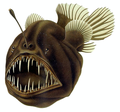 | Batesian mimicry is a form of mimicry where a harmless species has evolved to imitate the warning signals of a harmful species directed at a predator of... 28 KB (3,283 words) - 10:47, 23 March 2024 |
rather than mutual convergence), forming mimicry rings. Large rings are found for example in velvet ants. Since the frequency of mimics is positively... 32 KB (3,603 words) - 02:06, 2 April 2024 |
a close resemblance to ants. The nature of this ant mimicry (myrmecomorphy) varies, with some cases involving Batesian mimicry, where the mimic reduces... 149 KB (16,685 words) - 21:00, 30 April 2024 |
 | Mutillidae (redirect from Velvet Ant) predator of velvet ants, while the whiptail is not. The aposematic coloration of velvet ants often corresponds to a specific Müllerian mimicry ring consisting... 20 KB (2,233 words) - 23:33, 26 April 2024 |
 | Chemical communication in insects (section Mimicry) advantage. The process is important in ant mimicry where species that do not look like ants are accepted into the ant colony. In 1960, Dethier, Brown, and... 12 KB (1,086 words) - 14:43, 5 January 2024 |
 | Dasymutilla occidentalis (redirect from Eastern Velvet Ant) velvet ant species comprise one of the most intricate Mullerian mimicry rings in the natural world, being divided into eight separate rings of mimicry. These... 14 KB (1,697 words) - 21:35, 20 April 2024 |
 | Castianeira (section Ant mimicry) predators. Known ant-spider mimicry: Castianeira cingulata – short carpenter ants Castianeira longipalpa – myrmicine or ponerine ants Castianeira memnonia... 18 KB (1,277 words) - 17:29, 20 March 2024 |
ants (see Ant mimicry) Black Ant, a Marvel Comics character who is a Life Model Decoy of Eric O'Grady Ant List of ant genera (alphabetical) Ant (disambiguation)... 694 bytes (117 words) - 02:29, 6 December 2022 |
 | Myrmecophagy (category Ants) taxonomically distant. Ants are dangerous, small, and rich in distasteful and harmful compounds, making them difficult prey and favouring ant mimicry for defence... 14 KB (1,503 words) - 23:34, 26 April 2024 |
 | mimicry types including Batesian, Müllerian, host mimicry and ‘aggressive’ mimicry (see main article: Mimicry). A very frequent type is ant mimicry:... 80 KB (9,597 words) - 00:12, 18 April 2024 |
 | Myrmecophily (category Ants) such as myrmecomorphy – ant mimicry - and chemical mimicry to infiltrate ant nests, usually to prey on food supplies or the ants themselves. Aribates javensis... 33 KB (4,315 words) - 11:11, 17 February 2024 |
terrestrial mimicry is found in ant-mimicking spiders. These mimics are capable of antennal illusions and similar gait patterns as an ant, which is shown... 8 KB (1,009 words) - 19:43, 9 December 2023 |
 | Mark A. (23 May 2000). "Red legs and golden gasters: Batesian mimicry in Australian ants". Naturwissenschaften. 87 (5): 212–215. Bibcode:2000NW.....87... 138 KB (14,255 words) - 19:30, 16 April 2024 |
 | Brood parasitism (redirect from Brood mimicry) and raises them until pupation. Broodiness Host-parasite mimicry Kleptoparasite Slave-making ant Polistes semenowi was mistakenly named Polistes sulcifer... 36 KB (4,222 words) - 22:27, 25 April 2024 |
Pranburia (section Ant mimicry) Pranburia is a monotypic genus of Southeast Asian ant mimicking corinnid sac spiders containing the single species, Pranburia mahannopi. Christa L. Deeleman-Reinhold... 4 KB (392 words) - 15:20, 17 January 2024 |
 | Myrmaplata plataleoides (redirect from Kerengga ant-like jumper) taste bad and have a painful bite (Batesian mimicry). Mimicry is also achieved by stealing from the ant brood and absorbing the smell of the colony.... 4 KB (456 words) - 00:47, 16 February 2023 |
 | Camponotus planatus (redirect from Compact carpenter ant) (1974). "A Batesian Ant-Mimicry Complex from the Mountain Pine Ridge of British Honduras, with an Example of Transformational Mimicry". The American Midland... 5 KB (474 words) - 10:31, 9 February 2024 |
 | ant (Paratrechina longicornis), also known as the black crazy ant, is a species of small, dark-coloured insect in the family Formicidae. These ants are... 12 KB (1,498 words) - 07:58, 3 December 2023 |
 | Aphid (redirect from Dairying ant) cuticle that mimic those of the ants, and the ants carry them into the brood chamber of the ants' nest and raise them like ant larvae. Once there, the flat... 103 KB (11,232 words) - 09:40, 16 March 2024 |










